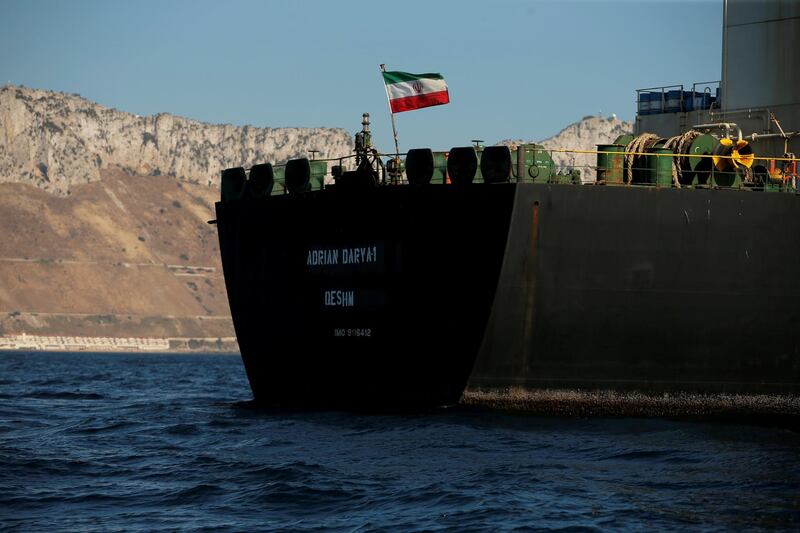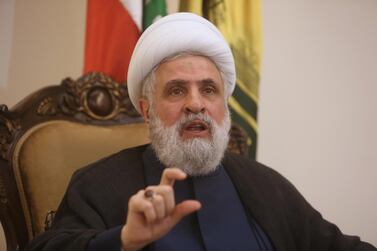The Iranian oil tanker Grace 1 came to a near-stop on Sunday off the coast of Syria, where it is suspected to be preparing to offload its cargo of 2.1 million barrels of Iranian crude.
Ship-tracking websites showed the Grace 1, which has been renamed Adrian Darya 1, had changed its destination from Iskenderun in Turkey to unlisted, and was hovering about 90 kilometres west of the Syrian cities of Tartus and Baniyas, which is home to an oil refinery, on Sunday afternoon.
The tanker changed course and destination several times after being released from detention in Gibraltar on August 18. It was seized by British troops on July 4 on suspicion of carrying oil to Syria in violation of EU sanctions and was freed after Iran gave an undertaking that its cargo was not bound for Syria, according to Gibraltar authorities. Iran denies giving such an assurance.
The tanker saga comes as tension remains high between the United States and Iran over its unravelling nuclear deal with world powers. Tehran is set to send a deputy foreign minister and a team of economists to Paris on Monday for talks on ways to salvage the accord after a phone call between Iranian President Hassan Rouhani and French President Emmanuel Macron.
US Secretary of State Mike Pompeo said on Saturday that the ship was believed to be bound for Syria
“We have reliable information that the tanker is under way and headed to Tartus, Syria,” Mr Pompeo wrote on Twitter. “I hope it changes course.”
Syrian President Bashar Al Assad’s adviser Bouthaina Shaaban separately told the Lebanon-based Al Mayadeen TV that Damascus is trying to get oil that its people need “but authorities don’t know where the Iranian tanker is heading”.
The Grace 1 had listed its destination as Greece after leaving Gibraltar but changed this to Mersin in Turkey after the US warned of action against any country that assisted the ship, which it had tried to impound before it left Gibraltar.
Iran said last Monday that the tanker's cargo, estimated to be worth $130 million (Dh477m), had been sold to an unnamed buyer. Anyone buying Iranian crude oil would be subject to US sanctions
The Grace 1 changed its destination to the Turkish city of Iskenderun on Saturday, after the US sanctioned the ship and its captain, but Turkey's Foreign Minister Mevlut Cavusoglu said it was heading to Lebanon. Lebanese officials said they had no knowledge of the Grace 1 being bound for the country.
Iran is pressuring European signatories to the nuclear deal to help it circumvent stringent US sanctions imposed after President Donald Trump pull out of the accord in May last year. Iran has committed incremental breaches on limitations placed on its nuclear programme under the accord and is set to raise its enrichment levels further this week if the European signatories – France, Britain and Germany – cannot offer substantial relief from the US sanctions.
The stand-off has raised fears of a new conflict in the Gulf region, with unclaimed attacks on several oil tankers that the US has blamed on Iran, and Iran shooting down a US surveillance drone.
On Sunday, Iran unveiled a jet-propelled drone that it said was capable of finding and attacking targets far from the country's borders with precision.
Dubbed the "Kian", the unmanned aerial vehicle was designed, produced and tested by experts of the air defence force within about a year, said the head of the force, Brigadier General Alireza Sabahifard.
The drone comes in two models capable of "surveillance and reconnaissance missions and continuous flight for precision missions", state news agency IRNA quoted him as saying.
"This drone can undertake any drone missions we entrust it with ... it can fly more than 1,000 kilometres and find its target with precision," he said.
The newly launched UAV can carry different munitions and can climb to an altitude of 5,000 metres, according to state television.






